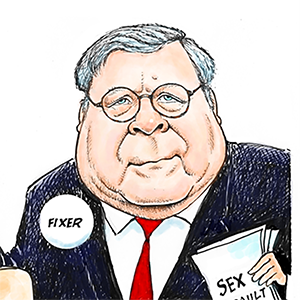They produce Florida's clams. To survive climate change, they're counting on Republicans
Published in News & Features
CEDAR KEY, Fla. -- Joseph Cannon was glued to the TV until the early morning hours of Nov. 6, when it had become clear that Donald Trump would be the next president. “People were so happy,” the tall, passionate Army vet recalls. He, too, was feeling a sense of hope he hadn’t felt in a while.
For the past 25 years, Cannon has been farming clams in the shallow Gulf off Cedar Key, the small island where he grew up with fish sandwiches for breakfast and fried mullet for dinner. But last week, he had to get away from the destruction and despair four hurricanes had caused in just 14 months, opting to spend some time with family in Illinois.
He needed distance, he said, because he had to contemplate the future, and whether he’d once again reinvest in the Florida’s battered clam industry.
“I’m a Republican, but I believe in climate change,” Cannon said last month in his office, a place where he’d been coming to cry, and to help fellow farmers fill in yet another application for disaster relief.
Until recently, some 200 Cedar Key farmers produced virtually every clam consumed in Florida, pulling in 120 million mollusks a year. Clamming had allowed them to fend off over-development and retain the island’s Old Florida charm that’s become so hard to find.
Hurricane Helene shattered that economic backbone. Cannon knows that not every single storm or the heat waves that have suffocated his clams in bathtub-warm waters can be attributed to climate change, but he sees how it’s made things worse. It’s impossible to deny the impact, he said, “if you’ve lived here any amount of time.”
As these impacts are set to become worse, Cedar Key’s backbone can’t just be restored as it was. It’ll need to be fortified. It can’t happen without help from the government – business loans and more disaster aid in particular, Cannon says.
Whether they’ll receive it now hinges on the Republican party, set to lead the House and Senate, and President-elect Donald Trump.
Cannon doesn’t worry about the president-elect calling climate change a “scam” or his plans to repeal climate legislation that is pumping $390 billion into mostly Republican districts. “The one thing that Republicans believe in is they believe in business,” he said. And his personal belief is that that they will “fix the situation, address the situation, but don’t give climate change the credit.”
The son of a local fisherman, Cannon joined the Army at 17, served in Haiti and Korea, and returned to make a living off the water. Out on one of his boats, it was easy to see why he loves his job: Spoonbills scraped for shrimp that will hue their feathers pink, and as Cannon zipped past pockets of mangroves imbued by warm morning sun, one dolphin popped its head through the surface, then another, and another.
“You get to watch the world come alive, and it’s God’s creation,” he said. Today, he has five kids – four of them stepchildren – 13 grandchildren, one great grandchild, a broken back and knee, and lots of pride and love for his work. He couldn’t have asked for more – if it wasn’t for the storms.
Early last month, Cannon’s crew dove into an aquatic mass grave with millions of casualties. Helene’s storm surge had pelted the island’s clam farms with such unprecedented force that almost none survived.
“Over to the left,” he directed 19-year-old Jeffrey Schleede, the son of another clammer, and 24-year-old Blake Buckley, who gave up a college baseball scholarship to clam. Clad in wetsuits and with PVC-coated gloves to protect them from cuts – though not the stingrays that have pierced through their fingers – Schleede found one of the nylon mesh bags in which the clams grow from microscopic to chowder-ready.
He poured thousands of clams out on the stern. They would have sold for $120, Cannon said, but he found just two survivors. “We’re looking at maybe 26 cents…maybe $1, if I keep looking.” Any clams that had survived Hurricane Debby in August, Hurricane Helene had finished off.
Across the globe, farmers know that any crops they grow can fail. Every once in a while, flooding will kill Spain’s tomato harvest, and a drought will leave Brazil’s coffee plants parched. In Cedar Key, farmers expect hurricanes to come in roughly seven-year cycles. It’s part of their risk assessment. Something they can account for.
Though last year’s Hurricane Idalia cost him $400,000 worth of clams, the hit was expected. “We were due for a storm,” Cannon said. “We looked at it and said, hey, it’s a storm. Let’s get cleaned up and get back to work.”
Any school kid in Cedar Key will tell you that storms are always followed by a period of calm and quiet, a truce nature offers to allow them to recover their losses. Cannon and his colleagues followed that wisdom. They went all in, invested millions back in the industry. Within 16 months, they’d have new clams to harvest. Another hit? “It doesn’t happen. It never happened.”
What farmers have been doing isn’t dissimilar from calculations made on a much grander scale. Insurance companies, banks, and FEMA all use historical data to project chances of future catastrophes.
But the temperatures in which the weather forms are now much warmer than in decades past. Over a 12-month period this year, they rose more than 1.5 degrees Celsius above levels observed before humans started burning industrial-levels of oil, gas and coal. The patterns we’ve observed – the climate – are unraveling.
Without the past to inform the future, projections are impossibly difficult.
Some farmers were still waiting for their disaster relief payments from last year’s Idalia. The programs need to work faster, a federal grant that has covered the paychecks for the five men he employs needs to be extended, and federal and state loans need to be adapted to ensure that clam farmers won’t have to repay them until they’re making profits, Cannon says.
That could be a long time. Clams take between 14 to 16 months to grow, exposing them to two hurricane seasons, give or take. On top of that, they died during heat waves, when oxygen levels in the Gulf drop so low they essentially suffocate, and struggle when increasingly common torrential rainfall dilutes the Gulf’s salinity.
Cannon hopes that the government will start treating them like other farms, that their risks will be mitigated by extending crop insurance to clams, and that the Farm Bill, currently stuck in Congress, will help put money into developing a more resilient GMO clam.
Whether the government will be willing to do so is a pressing question, particularly in Florida, the state whose economy and people are more threatened by the warming climate than anywhere else in the US.
On a tour of Cedar Key just days after Hurricane Helene, Sen. Marco Rubio, dressed in beige pants and a blue shirt, the go-to uniform politicians often don when they tour disasters, addressed the challenges.
Any effort to rebuild would need to “take into account that these events are becoming more common,” said Rubio, a fellow Republican likely to be influential with the incoming Trump administration. Cannon, his back facing the gulf, was intent on making the senator understand that it wasn’t just buildings that would need to be rebuilt better, but the clam industry that supports the island community.
It would be a “mammoth undertaking – I’m not sure it’s something that’s ever been done yet. But it’s something we should aim for,” Rubio said, who is now a leading candidate to become secretary of state.
Economic considerations will make things difficult, David Letson, an environmental economist who researches the social impacts of climate change at the University of Miami, said. Investments need to take a long-term view, “because every time you make investments – it may sound inhumane, but yeah, you’re doubling down. And you have to ask yourself: Is that wise?”
Four hurricanes in 14 months have already caused between $3 and $4 billion in damages on Florida’s farms, and the state is already bleeding taxpayers’ money into other programs, from windstorm insurance to a reinsurance entity, taking on enormous financial risks that will only become riskier. “Do you want to do something that further extends that?” Letson asked.
What’s clear is that the government’s – and taxpayers’ – pockets are finite. “You’re not going to be able to protect everything, unfortunately,” Letson said. Will Cedar Key and its clam farmers get the support they need? “It sounds like a really nice community,” Letson said, “but these are hard questions.”
Last month, Cannon drove his pickup past friends and colleagues, greeted each by name — Denis and young Brian, the old mayor and Phil — and wondered who’ll be able to stay. The word “purge” came to his mind.
Throughout its history, Cedar Key survived the loss of other industries. Its cedar mills, the railroad, and the whisk broom industry were all destroyed by hurricanes. Each time, the community reinvented itself. The latest hit was back in the 90s, when 72 percent of Floridians voted in favor of banning gill nets, which ended the type of commercial fishing that had kept Cannon’s and other families in Cedar Key.
“Son, don’t come home,” his father told him. Many left in bitterness, and Cannon stayed in the Army. Others, including Cannon’s father, gave the state’s proposal to start clamming a chance. Cannon was elated when he heard that it was working.
Clam farming wasn’t fishing, but he’d still get to make a living off the water, right here in Cedar Key. “I’ve been doing this for 25 years now, and I ask myself, Do I know what I’m doing?” He looks at Schleede and Buckley. They’re young, he says. “Am I going to help these guys further their lives, or do I need to get out of their way, and let maybe a new idea come in?”
Last week, he decided that it wasn’t time to give up yet. The election of Donald Trump lifted his spirits. He feels that a federal grant that has covered his employees’ paychecks will get extended, and that the farm bill will finally be passed. When land grabbers call, Cannon answers with expletives. In Cedar Key, new clams are already being put out in the Gulf. He feels confident about the future, he says. “In 16 months, I know I’ll be harvesting clams.”
____
This climate report is funded by Florida International University, the John S. and James L. Knight Foundation and the David and Christina Martin Family Foundation in partnership with Journalism Funding Partners. The Miami Herald retains editorial control of all content.
Miami Herald reporter Ashley Miznazi contributed to this story. Miznazi is a climate change reporter for the Miami Herald funded by the Lynn and Louis Wolfson II Family Foundation in partnership with Journalism Funding Partners.
©2024 Miami Herald. Visit at miamiherald.com. Distributed by Tribune Content Agency, LLC.






Comments